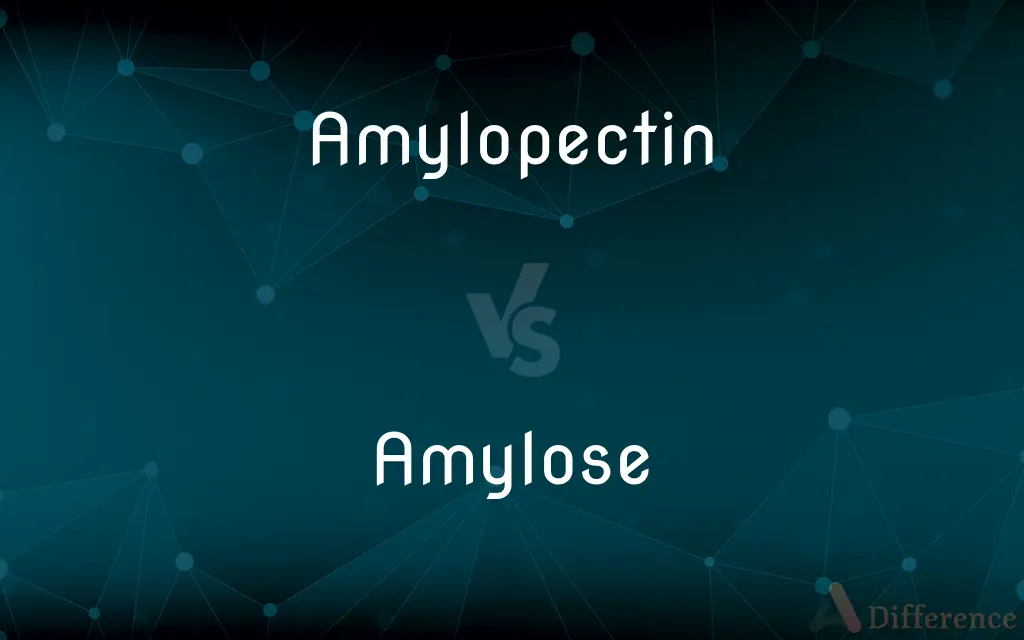Amylopectin vs. Amylose — What's the Difference?
By Maham Liaqat & Fiza Rafique — Updated on April 22, 2024
Amylopectin is a branched polymer of glucose, leading to quick energy release, while amylose is a linear polymer, resulting in slower digestion and energy release.

Difference Between Amylopectin and Amylose
Table of Contents
ADVERTISEMENT
Key Differences
Amylopectin is a highly branched molecule found in starch, which facilitates rapid digestion and quick glucose availability. On the other hand, amylose features a straight, unbranched chain that slows down enzymatic breakdown, thus delaying glucose absorption and providing sustained energy.
The structure of amylopectin, with its branch points about every 24 to 30 glucose units, allows enzymes to work simultaneously at many sites. Whereas, amylose, with its long linear chains, presents fewer points of attack for enzymes, leading to its slower digestion rate.
In terms of functionality in food, amylopectin gives a thick, gel-like consistency, which is why it's preferred in products needing viscosity like sauces and pastes. In contrast, amylose forms firm gels and is ideal for products that require structure, such as bread.
The impact on health also varies; amylopectin can cause a rapid increase in blood sugar levels, potentially undesirable for diabetics. Conversely, amylose has a more moderate impact on blood sugar, contributing to better glycemic control.
In industrial applications, amylopectin's quick-binding and thickening properties make it valuable in adhesives and biodegradable plastics. Amylose, with its ability to form films and barriers, is utilized in edible coatings and bioplastic components.
ADVERTISEMENT
Comparison Chart
Structure
Highly branched
Linear
Digestion Rate
Rapid
Slow
Function in Food
Thickening, gel formation
Forms firm gels
Health Impact
Rapid blood sugar increase
Slower blood sugar rise
Industrial Use
Adhesives, bioplastics
Edible coatings, plastics
Compare with Definitions
Amylopectin
A component of starch known for its branched structure.
The amylopectin in potatoes contributes to their fluffy texture when cooked.
Amylose
Contributes to better glycemic control due to its slower digestion.
Including amylose-rich foods in a diet can help manage diabetes.
Amylopectin
It facilitates rapid digestion and energy release.
Amylopectin is preferred in sports drinks for quick energy replenishment.
Amylose
Used in food to create firm gels.
Amylose is critical in the formulation of high-quality pasta.
Amylopectin
Leads to a rapid increase in blood sugar levels.
Foods high in amylopectin can affect blood sugar control in diabetics.
Amylose
Employed in creating biodegradable products and edible films.
Amylose is explored for its potential in sustainable packaging solutions.
Amylopectin
Valuable in manufacturing biodegradable plastics.
Amylopectin-based bioplastics are gaining popularity for being eco-friendly.
Amylose
Digests slowly, providing prolonged energy.
Foods rich in amylose are recommended for long endurance events.
Amylopectin
Used industrially for its thickening properties.
Amylopectin is a key ingredient in the adhesive used for label applications.
Amylose
A polysaccharide forming a major part of starch, noted for its unbranched chains.
Amylose content is higher in basmati rice, giving it a firmer texture.
Amylopectin
Amylopectin is a water-soluble polysaccharide and highly branched polymer of α-glucose units found in plants. It is one of the two components of starch, the other being amylose.
Amylose
Amylose is a polysaccharide made of α-D-glucose units, bonded to each other through α(1→4) glycosidic bonds. It is one of the two components of starch, making up approximately 20-30%.
Amylopectin
A highly branched polysaccharide of high molecular weight that is one of the two main components, along with amylose, of starches.
Amylose
A linear, unbranched polysaccharide that is one of the two main components, along with amylopectin, of starches.
Amylopectin
(carbohydrate) A highly branched, insoluble form of starch (the soluble form being amylose)
Amylose
(carbohydrate) The soluble form of starch (the insoluble form being amylopectin) that is a linear polymer of glucose.
Amylose
One of the starch group (C6H10O5)n of the carbohydrates; as, starch, arabin, dextrin, cellulose, etc.
Common Curiosities
What are the health implications of consuming foods high in amylopectin?
High amylopectin foods can lead to a rapid spike in blood sugar levels.
Which type of starch is better for quick energy release?
Amylopectin is better for quick energy release.
How does the digestion speed of amylopectin compare to amylose?
Amylopectin digests more rapidly than amylose.
Why is amylose considered better for diabetic diets?
Amylose digests slowly, leading to a more controlled increase in blood sugar.
What industrial uses do amylopectin and amylose have?
Amylopectin is used in adhesives and bioplastics, whereas amylose is used in edible coatings and bioplastic components.
Can the consumption of amylose affect glycemic control?
Yes, amylose can positively affect glycemic control by slowing glucose absorption.
Which starch component is more likely to cause a rapid increase in blood glucose?
Amylopectin is more likely to cause a rapid increase due to its branched structure.
What is the primary structural difference between amylopectin and amylose?
Amylopectin is branched, while amylose is linear.
Which component of starch is preferable for thickening sauces?
Amylopectin is preferable for thickening sauces due to its gel-like properties.
What are the benefits of amylopectin in bioplastic production?
Its quick-binding properties make amylopectin useful in producing biodegradable plastics.
How does amylose contribute to sustainable packaging solutions?
Amylose's film-forming ability is explored for creating biodegradable and edible packaging.
What role does amylopectin play in sports nutrition?
Amylopectin is favored in sports nutrition for its rapid energy release properties.
Which type of starch would you find more in pasta, and why?
Pasta typically has more amylose, which helps in forming a firm texture.
How do the properties of amylopectin and amylose influence their use in food technology?
Amylopectin is used for quick thickening and gel formation, while amylose is used to create firm structures.
What is a common application of amylopectin in the industrial sector?
Amylopectin is commonly used in the production of adhesives and thickening agents.
Share Your Discovery

Previous Comparison
Justification vs. Sanctification
Next Comparison
Hope vs. FaithAuthor Spotlight
Written by
Maham LiaqatCo-written by
Fiza RafiqueFiza Rafique is a skilled content writer at AskDifference.com, where she meticulously refines and enhances written pieces. Drawing from her vast editorial expertise, Fiza ensures clarity, accuracy, and precision in every article. Passionate about language, she continually seeks to elevate the quality of content for readers worldwide.
















































